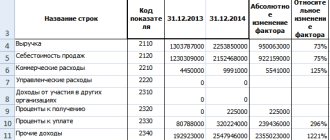Retained earnings (RE) is a common accounting concept that many businesses encounter. This term stands for funds received through the business activities of a company and available to it after paying tax deductions, dividends, fines, etc. Simply put, all mandatory payments.
An alternative name for retained earnings is retained surplus. In some cases, the concept of “profit retention ratio” is used.
The main difference between retained earnings and net profit is that it is always calculated not only for a specific period, but also for the total life of the enterprise. Whereas net profit is determined only for the reporting period. But at the end of the year, which is logical, both indicators may be the same.
Retained earnings (uncovered loss) in the Chart of Accounts for accounting of financial and economic activities of organizations.
Retained earnings in the balance sheet relate to the passive part of funds. By default, it is believed that it should be distributed among the owners and used to optimize the company’s business model. Until this point, such profit can only be called the company’s debt to its owners. Refers to long-term sources of financing, therefore the goal of the company’s financial strategy should be its mandatory accumulation.
What to do with retained earnings
There are several main ways to refer an NP. Among them:
- payment of dividends to owners/shareholders;
- compensation for earlier losses;
- accumulation of reserve fund funds;
- other goals agreed upon by managers.
IMPORTANT! Regarding the last point, it is worth making a small clarification. In this case, managers do not mean nominal officials, but business owners. As a rule, they resolve such issues during the final annual meeting, at which the corresponding minutes are drawn up.
How is profit distributed in an LLC (OJSC) using the simplified tax system and what remains for the NP
Most often, LLCs act as payers of the simplified tax system. The profit for its founders is dividends. According to Art. 28 Federal Law of the Russian Federation No. 14 “On LLC” dated 02/08/1998 (as amended on 04/23/2018), available profits can be distributed quarterly or once a year. The procedure for its distribution, as is customary, is fixed in the Charter, and the basis for this is the decision of the founders, which must be recorded at the meeting.
Meanwhile, there are a number of restrictions under which society has no right to make such decisions and share profits. Art. speaks about this. 29 Federal Law of the Russian Federation No. 14. Such restrictions, for example, are:
- presence of signs of financial insolvency of the company at the time of making a decision or payment;
- a situation in which the value of a private equity capital is less than its capital and reserve fund or may become less after a decision is made (or due to payment).
LLC participants have the right to make such decisions only after the management capital and the real price of the participant’s share (part thereof) have been paid in full in accordance with Federal Law of the Russian Federation No. 14.
If we are talking about the distribution of profit in a joint-stock company using the simplified tax system, then the procedure established by the Federal Law of the Russian Federation No. 208 “On Joint-Stock Companies” dated December 26, 1995 (as amended on April 15, 2019) is applied. Payment of dividends to shareholders can be carried out quarterly, half-yearly or at the end of the year. All decisions on payments are made and formalized by shareholders.
There are also restrictions on payments, which are established by Art. 40 Federal Law of the Russian Federation No. 208. They are in many ways similar to the prohibitions that are defined for LLCs. Thus, shareholders do not have the right to make decisions (or declare) payments until the management company has paid in full and all available shares have been repurchased (in relation to Article 76 of the Federal Law of the Russian Federation No. 208).
Important! The founders have the right to decide not to distribute all available profits, but only half or part of it. The remaining part remains in retained earnings.
It should be noted that it can be used not only for dividends, but also for other purposes. For example, to pay off past losses, mat. assistance, increase in capital, etc. From among the NPs, the company can form a certain reserve to pay for vacations and a repair fund. But spending NP for purposes not specified in the Charter or other documentation is prohibited.
For those who are simplified when maintaining accounts. and tax accounting, a standard procedure for each situation is established and applied. In the bay. accounting uses the accrual method, and in tax accounting the single tax is determined by the cash method. Moreover, in the latter case, when calculating the tax, only those expenses that are specified in Art. 346.16 Tax Code of the Russian Federation.
Thus, in the first and second cases, the display of operations will be different. That is why the accounting and tax accounting data will vary based on the results, which, in principle, is accepted as the norm.
Retained earnings. Check
All NP for the past years is summarized in accounting account 84, the balance credit balance is placed in line 1370 of the balance sheet. The same line contains the amount of uncovered loss (if any), which is indicated in parentheses. Uncovered loss means the difference between the company's expenses and income during the year, according to which the first point exceeds the second.
The account contains information about the denomination and changes in the amount for the reporting year. At the end of the year, the amount is credited to account 84, while the loss is written off as a debit. The main task of this account is to store information about the purposes for which the funds were used.
An uncovered loss is sometimes called a deficit profit. The loss can be fully or partially compensated using reserve capital funds. In the case of compensation, data on the initial loss is not filled in (in case of partial compensation, only the remaining amount of the loss is indicated in parentheses).
IMPORTANT! At the request of the accounting department, additional lines – 1371 and 1372 – can be entered in the balance sheet to differentiate the figures for the reporting and previous years.
What is included in the concept
Where can retained earnings be used? To understand this, you need to consider the essence and features of its calculation. This income is also called accumulated profit. It remains at the enterprise after paying all taxes, fines, and other obligatory payments. Also, the concept presented closely intersects with net profit.
Profit requiring distribution is a resulting indicator that reflects the company's performance for the entire period. Net income reflects how the company performed during the reporting period.
Accounting considers profit before distribution as a final indicator, which is reflected in account 84 of the organization’s reporting. It is not distributed, but brought to a single result. How to distribute profits will be decided by shareholders at a meeting that takes place after the close of the reporting period in the spring or summer.
The calculation of profit before distribution is carried out according to a certain scheme. To do this, take data from account 90 “Sales”. This reflects the amount of profit from the sale of goods, provision of services or work. This information is reflected on the loan. The debit of account 90 shows the cost of production. VAT is also charged here and other costs are reflected.
In the process of generating income that requires distribution, the final balance from the specified account is transferred to account 99. It's called Profit and Loss. If a profit is made, the accountant records the funds as follows:
- Dt 90 Kt 99.
If the balance of account 90 is negative, the posting looks like this:
- Dt 99 Kt 90.
The result of operations from operating and non-operating activities is reflected in account 91. It is called “Other income and expenses.” The following transactions are reflected in this account:
- sale or lease of assets that belong to the enterprise;
- depreciation or revaluation of non-current assets;
- profit from transactions with foreign currency;
- investing in the authorized capital of other organizations;
- donation or liquidation of property;
- income (expenses) from procedures with securities.
The following entries can be made to this account:
- Dt 91 Kt 99 – profit for the reporting period is determined.
- Dt 99 Kt 91 – a loss was incurred.
Calculation of retained earnings. Detailed formula
So, we found out that retained earnings are the amount of funds remaining at the disposal of the company’s owners after all taxes and other mandatory deductions. This indicator can be calculated using the formula:
HPk = HPn + ChP – D
Where:
- HPc – surplus of funds at the end of the reporting period;
- HPn – the same indicator at the beginning of the period;
- PE – net profit minus income tax;
- D – dividends distributed for the reporting period, based on the RR of the previous periods.
Note: The standard reporting period is one year.
If during the current period the company received a net loss instead of profit, the formula takes on a slightly different form:
NPk = NPn – CHU – D
Where:
- HPc – surplus of funds at the end of the reporting period;
- HPn – the same indicator at the beginning of the period;
- NL – net loss;
- D – dividends distributed for the reporting period, based on the RR of the previous periods.
The remaining indicators are similar to the previous formula.
Question: Does an LLC have the right to make incentive payments to employees from retained earnings and how to formalize this, and are they taken into account when calculating the average salary? View answer
"Special Purpose Funds"
The current Chart of Accounts (approved by order of the Ministry of Finance of Russia dated October 31, 2000 No. 94n) does not provide for separate subaccounts for the creation of special-purpose funds (in the previous Chart of Accounts of 1992, account 88 “Retained earnings (uncovered loss)” provided for subaccounts “Consumption funds " and "Accumulation funds").
Sometimes the owners of an organization decide to pay bonuses to employees and financial assistance from net profits. Some even decide to create so-called consumption and accumulation funds, charitable foundations.
Important
The laws on JSC and LLC do not provide for any payments from profits to anyone other than the owners. And account 84 “Retained earnings (uncovered loss)” is the account of the owners, and only they have the right to receive dividends.
And the Russian Ministry of Finance has repeatedly indicated that account 84 is not intended to reflect all kinds of social and charitable expenses, payments of material assistance and bonuses (see, for example, letters of the Russian Ministry of Finance dated June 19, 2008 No. 07-05-06/138, dated 19 December 2008 No. 07-05-06/260).
Expenses of an organization are recognized as a decrease in economic benefits as a result of the disposal of assets (cash, other property) and (or) the emergence of liabilities, leading to a decrease in the capital of this organization, with the exception of a decrease in contributions by decision of participants (owners of property) (clause 2 of PBU 10/99) .
Organizational expenses for sporting events, recreation, entertainment, cultural and educational events and other similar events, as well as transfers of funds to charity, are other expenses and should be accounted for in account 91 “Other income and expenses.”
In other words, any disposal of assets (except for dividends) is an expense of the current period (clause 2 of PBU 10/99). They have nothing to do with the organization's net profit. Such expenses cannot be debited to account 84; this is contrary to current accounting regulations.
So, if the owners want the company to buy an operating system from profits or spend money on charity, the accountant needs to record such costs in the usual way as assets or expenses. When purchasing fixed assets, organizations simply spend funds from the current account and one asset (money) is exchanged for another (fixed asset).
And the organization’s expenses for paying bonuses to employees, transferring funds to charity, and the like are always recognized as expenses of the organization and are reflected in the financial results statement. Account 84 is not used in postings.
Acquisition of fixed assets
Based on the Instructions for using the Chart of Accounts, you can organize accounting for sources of capital investments, and in this case account 84 will be used. This must be provided for in the accounting policy.
The use of profit for the acquisition of fixed assets is reflected in accounting by the following entries:
DEBIT 01 “Fixed assets” CREDIT 08 “Investments in non-current assets”
- the object is included in fixed assets;
Simultaneously
DEBIT 84 “Retained earnings (uncovered loss)” CREDIT 84
“Retained earnings (uncovered loss)”, subaccount “Retained earnings aimed at purchasing fixed assets”
— net profit is used to purchase property.
EXAMPLE The accounting policy of JSC Aktiv (general taxation system) defines the source of financing for capital investments - retained earnings. The Aktiva accountant opened a subaccount for account 84, “Retained earnings aimed at acquiring fixed assets.” In April of the current year, a fixed asset worth 53,100 rubles was purchased. (including VAT - 8,100 rubles). The accountant made the following entries: DEBIT 08 CREDIT 60 - 45,000 rubles. - fixed asset purchased; DEBIT 19-1 CREDIT 60 - 8100 rub. – “input” VAT is taken into account; DEBIT 01 CREDIT 08 – 45,000 rub. - the acquired fixed asset is accepted for accounting; DEBIT 68 CREDIT 19-1 - 8100 rub. - “input” VAT is accepted for deduction; DEBIT 84-2 CREDIT 84-3 – 45,000 rubles. – the source of financing is reflected (the use of net profit for the purchase of fixed assets).
The essence of revenue before distribution and uncovered loss
Having considered to which account retained earnings should be accrued and how this process occurs, you need to pay attention to the essence of the presented category. This is an absolute indicator that reflects the efficiency of the enterprise. In accounting, there are no significant differences between profits requiring distribution and uncovered losses. The difference is in the wiring. The debit and credit of accounts when making a profit or loss are different.
In most cases, a company that has been operating for several years covers excess costs with the remaining revenue from previous years. Funds can also be written off from the reserve fund, additional or authorized capital.
If a profit is made, the organization has the right to independently decide for what purposes it should be directed. The decision is made at a meeting of shareholders. Depending on the current market situation, as well as within the company itself, the direction for financing is selected. There are several directions for distributing the net profit received in the reporting period.
Retained earnings are reflected in the liability form No. 1. In this case, there is an increase in capital due to retained earnings. These are the organization's own funds that can be reinvested in production. Based on the indicator of profit before distribution, one can draw a conclusion about the effectiveness of the means used in production. If you analyze in detail the information that is used to calculate the presented indicator, you can draw conclusions about what factors influenced it in the reporting period.
If the organization received a loss, its amount is reflected with a minus sign and is taken in parentheses in the balance sheet. In this case, it is extremely important to determine why the company did not make a profit in this period. There are many factors that lead to a drop in income. They must be identified, and then a technique must be developed to prevent negative effects in the future.







